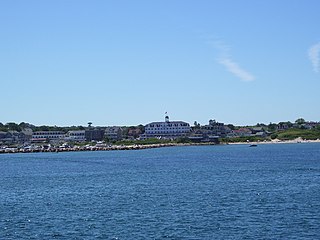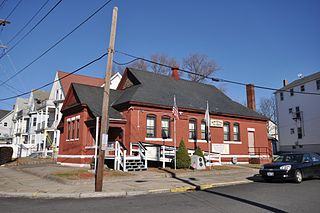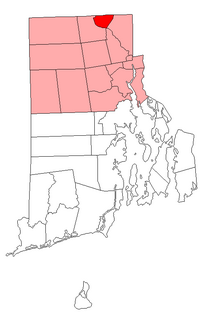
Woonsocket, is a city in Providence County, Rhode Island, United States. The population was 43,240 at the 2020 census, making it the sixth largest city in the state. Being Rhode Island's northernmost city, Woonsocket lies directly south of the Massachusetts state line and constitutes part of both the Providence metropolitan area and the larger Greater Boston Combined Statistical Area.

The Smith–Ballou House is an historic house at 641 Harris Avenue in northwestern Woonsocket, Rhode Island. The 1906 house is listed on the National Register of Historic Places.

The Clemence–Irons House is a historic house located in Johnston, Rhode Island. It was built by Richard Clemence in 1691 and is a rare surviving example of a "stone ender", a building type first developed in the western part of England and common in colonial Rhode Island. The house is listed on the National Register of Historic Places, and is a historic house museum owned and operated by Historic New England. It is open Saturdays between June and mid-October.

Union Village or "Bank Village" is a village and historic district located in North Smithfield and Woonsocket, Rhode Island on Rhode Island Route 146A. Union Village developed because it was at the cross roads of old Great Road and Pound Hill Road.

The Smithfield Friends Meeting House, Parsonage and Cemetery, is a Friends Meeting House of the Religious Society of Friends (Quakers), rebuilt in 1881. It is located at 108 Smithfield Road in Woonsocket, Rhode Island. The meetinghouse is home to one of the oldest Quaker communities in the region.

The 1761 Milestone is a mile marker located at 640 South Main Street in Woonsocket, Rhode Island. The stone originally marked the junction of a Colonial highway from Great Road and an east-west route from Boston, Massachusetts to Connecticut. It was rediscovered during the installation of an electrical road. In 1898, it was restored to its original location by the local chapter of the Daughters of the American Revolution. The stone is embedded in a low retaining wall at the corner of South Main Street and Smithfield Road. It was added to the National Register of Historic Places on November 24, 1982, and is historically significant as a Colonial-era highway marker.

The Woonsocket City Hall, is located in Woonsocket, Rhode Island.

The John Arnold House is an historic house on 99 Providence Street in Woonsocket, Rhode Island. The main block of this two-story wood-frame house is conventionally believed to have been built in 1712, but there is architectural evidence parts of it may be even older. There are two additions: a two-story gable-roof section extending south, to which a mid-20th-century addition has been made. Elements of the house's antiquity remain in the main block despite its conversion to multiunit housing. The house is presumed to have been built by John Arnold, grandson of early Rhode Island settler William Arnold.

The Cato Hill Historic District is a residential historic district in central Woonsocket, Rhode Island. It consists of about 2-1/2 blocks of Church and Cato Streets, as well as the streets crossing them. The area, located on a hill just above Woonsocket's downtown area, is a densely populated area built primarily between 1838 and 1875, during Woonsocket's growth as a major textile processing center. Cato Hill is named for Cato Aldrich, an African American who purchased the land from the Arnolds who founded Woonsocket. The houses of the district exhibit vernacular forms of the architectural styles popular in the mid-19th century.

Honan's Block and 112–114 Main Street are a pair of joined commercial buildings in Woonsocket, Rhode Island. Honan's Block is a visually distinctive three-story brick Stick/Eastlake-style building erected in 1879. The adjacent 112–114 Main Street is an L-shaped two-story block which wraps around the rear of the Honan Block. The two buildings were joined via internal connections in 1938–39, at which time the facades of both buildings were significantly altered, although the Honan Block has retained its distinctive Late Victorian cast-iron elements.

The Main Street Historic District is a historic district in the central business district of Woonsocket, Rhode Island, USA. It extends along Main Street, between the railroad tracks just northeast of its junction with Clinton Street, and roughly Ascension Street at the southwest. Most of the sixteen buildings in this area were built at the height of Woonsocket's prosperity, roughly between 1850 and 1930. The district is characterized by brick and masonry buildings generally between two and six stories in height.

Woonsocket Rubber Company Mill is an historic mill at 60-82 Main Street in Woonsocket, Rhode Island. The mill consists of a series of 3- and 4-story brick buildings built between 1865 and 1875 by Edward Harris, one of Woonsocket's leading businessmen. These buildings housed the Woonsocket Rubbert Company, one of Rhode Island's first manufacturer of rubber products, principally shoes, boots, and rubberized fabric. In 1910 the complex was purchased by the Falls Yarn Company, which used it for the production of fine woolen yarns.

The Frank Wilbur House is a historic house in Woonsocket, Rhode Island, USA near Park Square, Rhode Island. Built c. 1923, this is an architecturally distinctive bungalow form with Japanese elements. It has a complex roof line with three gables and an L-shaped entrance porch with posts mounted on high yellow-brick piers. The front windows are organized in threes with small colored-glass panes flanking clear glass. Wilbur was a farmer who built this house between his farm and Woonsocket Agricultural Society fairgrounds, which is now Our Lady Queen of Martyrs Church.

The St. Charles Borromeo Church is a former Roman Catholic parish church in Woonsocket, Rhode Island, located on North Main Street. The parish of St. Charles was canonically suppressed January 12, 2020 and the congregation merged with that of the Church of All Saints, another parish of the Diocese of Providence, although the church remains open as an alternative worship space.

The South Main Street Historic District is a residential historic district in Woonsocket, Rhode Island. It extends along South Main Street between Mason Street on one end and Andrews and Bradford Streets on the other, and includes properties on adjacent streets, principally Ballou and North Ballou Streets. The district includes 65 main properties, most of which were built between 1880 and 1930, although there is a cluster of older properties in the northern half of the district. The district typifies the American main road leading into a town, lined by landscaped lots with high-quality houses.

The Old Harbor Historic District is an historic district in the resort community of New Shoreham on Block Island off the southern coast of Rhode Island. Bounded by the Atlantic Ocean and Main Street, it includes Spring, High, and Water streets as well. There are 42 buildings listed in the district, which was listed on the National Register of Historic Places in 1974.

The Fifth Ward Wardroom is a historic meeting hall at 47 Mulberry Street in Pawtucket, Rhode Island. It is a single-story red brick building, with a low-pitch hipped roof. Basically rectangular, an enclosed entry pavilion projects from the main block. The building was designed by William R. Walker & Son and built in 1886. Originally used as a polling place and meeting hall, it was later used as a school and by veterans organizations before being converted into a single family residence during its National Register of Historic Places nomination. It was listed on the historic register in 1983.

The First Ward Wardroom is a historic meeting hall at 171 Fountain Street in Pawtucket, Rhode Island. It is a single-story red brick building, with a low-pitch gable-over-hipped roof. Basically rectangular, an enclosed entry pavilion projects from the main block. The building, designed by William R. Walker & Son and built in 1886, is one of only three ward halls to survive in the state. Since about 1920 it has been the Major Walter G. Gatchell Post No. 306 of the Veterans of Foreign Wars. The building was listed on the National Register of Historic Places in 1983.

This is a list of National Register of Historic Places listings in Woonsocket, Rhode Island.

The First Universalist Church is a former Universalist church at 78 Earle Street in Woonsocket, Rhode Island. Built in 1924 and enlarged in 1957, it is a good example of 20th-century Gothic Revival architecture. The congregation for which it was built was established in the 1820s, in part through the efforts of Hosea Ballou, an influential early Universalist minister who also had business interests in Woonsocket. The congregation was disbanded in 2007, and the building now houses the American-French Genealogical Society. It was listed on the National Register of Historic Places in 2020.





















